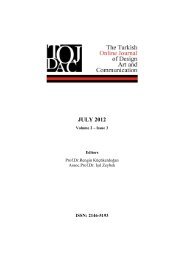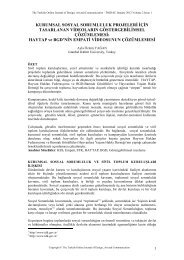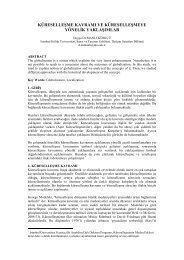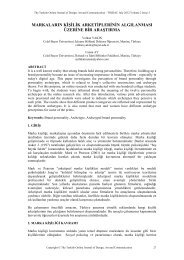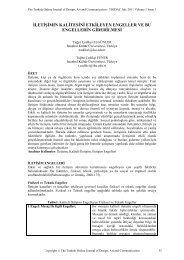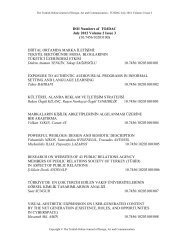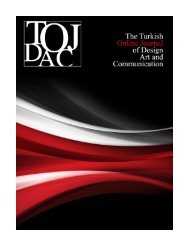aprıl 2012 - tojdac.org
aprıl 2012 - tojdac.org
aprıl 2012 - tojdac.org
Create successful ePaper yourself
Turn your PDF publications into a flip-book with our unique Google optimized e-Paper software.
The Turkish Online Journal of Design, Art and Communication - TOJDAC April <strong>2012</strong> Volume 2 Issue 2<br />
!<br />
There is a temptation to use coloured light to obtain a dramatic effect. This can be very<br />
successful, but only in very specific and appropriate circumstances. In general, a building<br />
usually benefits from unifying effect of a single colour of light or, occasionally, a subtle<br />
change of colour with direction. It is the revealing power of the light that should be harnessed<br />
in the scheme’s design. Light from a prominent direction can display a building very<br />
successfully by allowing the varying orientation of the building’surfaces to create the<br />
shadows necessary to reveal its features [7].<br />
Viewing Points – Proximity; In outdoor and architectural lighting, viewing directions of the<br />
observers also has to be kept in mind for the lighting master plan. Viewing points for the<br />
visitors or people passing by should be known to decide the aiming directions of the<br />
luminaires, while eliminating the glare. Facades shall be illuminated in a way to overcome<br />
flatness and being uninteresting. As far as possible, the direction of the lighting should not be<br />
from the same direction as the main direction of view of people looking at it.<br />
4. CONCLUSION<br />
In this study, historical and contemporary masterpieces in Istanbul is discussed and analyzed<br />
considering “lighting scheme” as a design tool in the “lighting master plan”. The present<br />
image of the city is analyzed together with the light mapping tool. In the transformation and<br />
interpretation of the historical identity to the city silhouette, light was used to formulate this<br />
idea. According to the results, there are three key factors to effective lighting on cities:<br />
• Practical, feasible and functional. Lighting scheme must be sensitive to the character<br />
of the city and must address the needs of the city in a way that meets the city’s<br />
objectives.<br />
• Holistic design. Lighting scheme must include all the components of the outdoor<br />
urban environment, maximizing the value of the night lighting and minimizing all the<br />
potential adverse effects.<br />
• Technically aware. There is no need to light everything all night or to light at the<br />
same level late at night as early in the night.<br />
REFERENCES<br />
[1] Lynch K (1981). A Theory of Good City Form, MIT Press, Cambridge.<br />
[2] Oktay D (2002). The Quest For Urban !dentity !n The Changing Context Of The City<br />
Northern Cyprus, Cities 19: 261–271<br />
[3] Thompson CW (2002). Urban Open Space !n The 21st Century, Landsc. Urban Plan. 60:<br />
59–72.<br />
[4] Lynch K (1960). The Image Of The City,The MIT Press, Cambridge.<br />
[5] Cartier, J. (1998). Lumieres Sur la Ville-l’amenagement et la Ville Nocturne: De la<br />
Pratique Professionnelle A L’ Usager, ANTPE, Ales, p:275<br />
[6] Bordonaro, E., Aghemo,C., (2006). Urban Lighting= A Multidisciplinare Approach,<br />
Urban Nightscape 2006 Conference Proceedings<br />
[7] Bean, R., (2004). Lighting: Interior And Exterior, Elsevier Architectural Press,p: 229<br />
Copyright © The Turkish Online Journal of Design, Art and Communication 78



